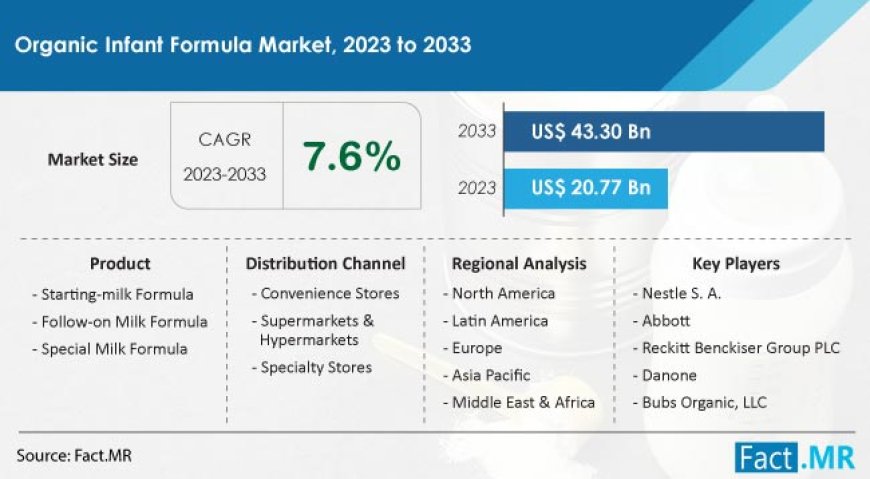Organic Infant Formula Market is Estimated to Reach US$ 43.30 Billion by 2033

The market for organic infant formula is anticipated to grow to $20.77 billion in US dollars by 2023. A recent analysis by market research and competitive intelligence provider Fact.MR projects that the industry will expand at a compound annual growth rate (CAGR) of 7.6%. Growing public awareness of organic baby formula’s potential benefits is opening up lucrative prospects for industry players.
Organic infant formula is free from pesticides, hormones, and chemicals. The rising traction for healthier food options for kids is predicted to drive opportunities for players. The opening of new markets in emerging regions is estimated to open up lucrative opportunities.
Get Free Sample Copy of This Report:
https://www.factmr.com/connectus/sample?flag=S&rep_id=8860
A majority of parents are becoming educated related to the potential risks of traditional infant formula. Organic infant formula is described as a synthetic nutritious food prepared for kids of less than 12 months. It is generally used as a substitute for breast milk. Compared to the traditional formula, organic infant formula is produced from natural ingredients, including dairy milk and soy products, which are free from hormones, pesticides, and chemicals.
Key Takeaways from Market Study
The global organic infant formula market stands at US$ 20.77 billion in 2023.
The market is predicted to expand at a CAGR of 7.6% from 2023 to 2033.
Sales of organic infant formula are anticipated to reach US$ 43.30 billion by 2033.
The special milk formula segment accounted for 35.1% share of global market revenue in 2022.
Specialty stores held 70% share of industry revenue in 2022.
Rising Cases of Breast Cancer in the United States Generating Demand for Organic Infant Formula
The United States market is projected to hold a significant share in the North American region. Growing sales of organic infant formula in the country are attributed to the rising incidences of breast cancer among various female Americans.
Increasing awareness among the female population related to the existence of these products is predicted to positively influence market opportunities. Moreover, the increased purchasing power of numerous Americans due to a prosperous economy is also contributing to the rising sales of organic infant formula.
High Production Cost and Implementation of Stringent Government Regulations Adversely Impacting Market Expansion
The cost associated with the production of organic infant formula in comparison to traditional formula is creating challenges for suppliers in the form of reduced product demand. Certain stringent regulations and quality control measures are implemented by respective governing bodies to ensure product quality. These measures are projected to lead to increased costs of manufacturing and thus limit product affordability for various consumers globally.
Manufacturers need to adhere to stringent regulations and certifications that are time-consuming and complex. Therefore, sometimes the task of producing organic infant formula becomes tiresome for some producers.
Get Customization on this Report for Specific Research Solutions:
https://www.factmr.com/connectus/sample?flag=RC&rep_id=8860
Winning Strategy
Prominent companies are involved in mergers, acquisitions, and other similar activities to gain a competitive edge in the market.
For instance,
Nestle S.A. is a renowned processor of food and drinks, based in Vevey, Switzerland. On August 09, 2021, it announced the acquisition of The Bountiful Company, based in New York, US, and is well-known for its dietary supplements.
Key Companies Profiled in This Report
Nestle S. A.,
Abbott,
Danone,
Reckitt Benckiser Group PLC,
Perrigo Company PLCS,
Bellamy’s Organic,
Friesland Campina,
Shijiazhuang Junlebao Dairy Co., Ltd.,
Heilongjiang Feihe Dairy Co., Ltd.,
Friesland Campina,
Bubs Organic, LLC
Segmentation of Organic Infant Formula Industry Research Report
By Product :
Starting Milk Formula
Follow-on Milk
Special Milk Formula
By Distribution Channel :
Convenience Stores
Supermarkets & Hypermarkets
Specialty Stores
By Formulation :
Powdered Formula
Concentrated Milk Formula
Ready-to-feed Formula
By Region:
North America
Europe
Asia Pacific
Latin America
Middle East & Africa

 swatichaudhari
swatichaudhari 










